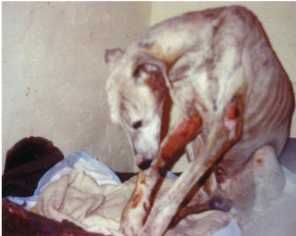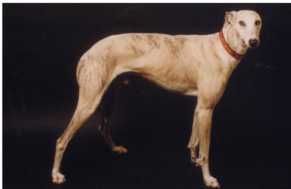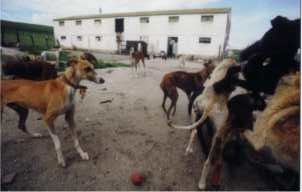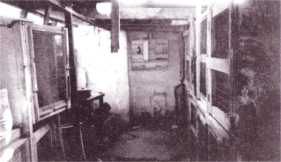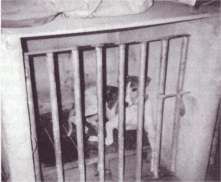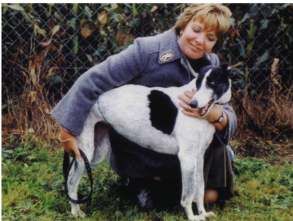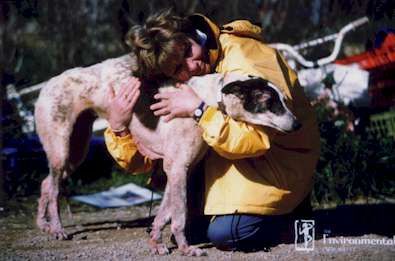“The Greyhounds and Galgos of Spain”, chapter written by Anne Finch in 1999, for the book All Bets Are Off!: The Race for Survival for the Greyhounds of Spain, published by Greyhound Friends North Carolina, available from the GIN Shop at £12. The book was edited by Karen Weyler, assistant professor in the Department of English at the University of North Carolina at Greensboro. Written contributions were invited from those involved with the work for the greyhounds of Spain.
This subject of greyhounds in Spain has become a contentious issue among lovers of the breed and conjures up images of abuse and cruelty.

A rescued galgo in Spain, already emaciated and barely able to sustain her own life, struggles to provide milk for her puppies. Photo Anne Finch
Much emotion, media coverage, and energy have been spent on the subject, quite predictably, and certain inroads have been made over the last nine years to modify the situation. I intend, in this chapter, to be as informative and as unbiased as possible and to give a truthful and fair picture of what really befalls the greyhound in Spain. It is not an easy chapter to write as there has been little research done on the subject, and the limited amount that exists is not in English.
Many aspects of the history of the greyhound are hidden in the folklore and traditions of internal Spain. History, politics, and culture have played significant roles in the decline and rise in popularity of the greyhound as a sporting and hunting dog and continue to exert influence in modern Spain, who has herself undergone profound changes in the last thirty years.
Most people think of dog racing tracks when they talk of the greyhound. We in Britain and the USA have lived with track racing since the 1920s, and we do not have to stress here the enormous problems that such a sport poses to greyhound lovers like ourselves when we are faced with having to care for and find homes for thousands of unwanted, retired, and often injured racers, still in the early years of their lives.
In Spain, the problems are even greater. There are dog tracks with Irish imported racers, but also there is a very strong tradition of hunting the live hare in the countryside using Spain’s own country-bred greyhounds called “Galgos”. There is even a third use of the greyhound called “straight racing with mechanical lure.”As it implies, the dogs run straight along a rough track having been released simply by hand from their owners. They chase after a lure dragged by a wire on a reel. We will look later at each of these sports, the dogs they use, and the concurrent problems, but first let us go back to the very beginning – how the greyhound came to Spain in the first place.
History
The word “galgo” is either a straight translation of the word greyhound or, if we are being more precise, refers to the Spanish-bred greyhound as distinct from the Irish greyhound known as the “galgo Ingles”.There are two other words “lebrel” or “lebrero,” used synonymously with the galgo, or more loosely referring to any sight hound.The Catalan word for a greyhound is “llebrer,” like the French “levrier,” which derives from the word for the hare, “liebre” or lievre.”The last dog tracks to survive in Spain were all in Catalan-speaking areas.
As always, there is a conflict in opinion as to how the greyhound came to Spain. Some say they originated in Egypt and Arabia.The Pharaonic Hound appears on the walls of the tombs of ancient Egypt, the only main difference being the “desert ears” (erect ears) as opposed to the rose-shaped ears of the Spanish hound. The Moroccan sloughi reminds us strongly of the galgo, though a sloughi’s ears ware wider and come forwards, whereas the Spanish hound’s ears go backwards. One can see both geographically and historically how this dog found its way with the Arabs from North Africa across the straits of Gibraltar into Spain. The name “galgo” may even imply that the hound came from Gaul with the Celts when they settled in the Peninsular. “Galgo” may also mean “very thin” as the word in Spain paradoxically means someone who wants to eat a lot of sweet things!
The Arabs moved into Spain in the 700s. Hunting on horseback with greyhound-like dogs running alongside the horses was a favourite sport among Arabs. It is interesting to note that dogs in general are regarded as unclean in the Islamic tradition. Rumour has it that the prophet Mohammed was bitten by a dog. The one exception is the sight hound, which is greatly respected. To this day, the saluki, for instance, is so revered by their Bedouin breeders in the desert that their women suckle the pups with their own milk. They are permitted to live inside the tents, and no one can buy a saluki from the Bedouin. The dog can only be given as an honoured gift and as a token of highest respect for the recipient. With La Reconquista, when the Arabs were driven out of Spain between the eleventh and thirteenth centuries, the abandoned lands began to be repopulated by the Christians, mainly stretching from the Duero area in Castilla across to Toledo. The main means of survival for these people was to convert the land into pasture, and the damaging effect of deforestation followed, becoming later an environmental disaster. These plains were perfect, however, for the breeding of game and hare and for sport involving the chase. These flat, wide-open hunting areas are the same today as then: the northern plateau, Vallodolid, Zamora, Avila, Salamanca, Segovia, Soria, Burgos and Palenciia: and the southern plateau, Toledo Cuenca, Guadalajara, Madrid and Cuidad Real.
The greyhound was highly revered by the nobility, and a great number of laws existed to protect it. Historically, however, in Spain, unlike the rest of Europe, greyhounds were the property not only of noblemen, but also of enthusiastic peasants. A greyhound owner is called a “galguero,” and he is proud of his dog, which reflects his own status in the community. Furthermore, the gypsy community is a large minority in Spain and also has a long tradition of living with greyhounds, which in days past were used by their owners to hunt for food. He who had the best galgo had the best position in the group.
The greyhound even infiltrates Spain’s literary and historical heritage. In 1605, Spain’s greatest writer and poet, Miguel de Cervantes, wrote his masterpiece, Don Quixote, about a medieval-type knight who believes in Gallantry and courtly love, fantasizes of glorious battles, and combats with “monsters” for the love of a lady. It opens with these words: “In a place of La Mancha, whose name I do not want to remember, not very long ago, lived an hidalgo, one of those who bears a lance in the rack, an ancient shield, a skinny horse and a coursing greyhound.”
The greyhound is an accepted accoutrement of the Spanish warrior. El Cid Campeador, the warrior hero of La Reconquista, kept greyhounds and was observed always to feed his greyhounds before leaving his house to lead his troops.
More modern history shows a change as the movement of people from the country to the towns to find work caused a decline in hunting with dogs. An interest in the 1920s began in the new sport started in America of greyhound racing around a track. The Irish developed the most perfect greyhound for this purpose, lighter than the coursing dog, with early speed and sprinting ability reaching such speeds as 40 mph within a second or two on the track of only 300-400 meters. Velocity is more important that staying power; the dog is less resistant, more sensitive, and so keen it will chase a moving soft toy, not just a live hare. This is the Galgo Ingles (literally English Greyhound), which began to be introduced into Spain in the early 1900s. Then began a regretful, indiscriminate cross breeding between the Galgo Ingles and the Spanish Galgo in order to make it more adaptable to the shorter coursing runs, especially in Andalucia, where fencing, irrigation canals, and reforestation interrupted the countryside and necessitated more sprinting ability and less endurance than the long open runs of Castilla and the central plains. Furthermore, as the sport became more competitive and more for the benefit of spectators and trophies, shorter and faster runs were again more desirable.
Certain aficionados and specialized breeders of the Spanish galgo deeply regret the enormous imports of Irish greyhounds, especially from the 1950s onward, as they feel that the original galgo has lost many of its essential characteristics. The import of Irish greyhounds was encouraged by the Federacion Espanola de Galgo in order to raise the number of dog tracks between the 1930s and the 1970s. Between 1912 and 1930, forty-four dogs were exported from Ireland to Spain. Between 1978 and 1979, 2,700 greyhounds were exported to Spain. There is almost no breeding in Spain of track dogs, so Spain buys “dreg” quality bitches (slow or injured hounds, fighters, etc.) from Ireland. Bitches are preferred because the Spanish tracks are small, and the tight curves necessitate a smaller dog. Accounts of sales show that Spain pays less per dog than any other country. Purists believe that this vast impost weakened a pure breed of dog. The dog tracks increased as the “galgo en campo” decreased.
In the late 1960s and 1970s, as young people became more affluent, there came a trend back to the idea of hunting again as second houses in the country could be afforded by city dwellers, and hunting on weekends became more popular. In 1975 General Franco died, and democracy was established. Gambling on a wider scale was permitted, heralding a loss of particular interest in the eighteen dog tracks throughout the cities of Spain, which hitherto had been one of the few places where one could indulge in betting.
The dog tracks continue to decline, leaving only one at the time I write, in Barcelona, holding upwards of seven hundred Irish Greyhounds, mostly bitches. Hunting with galgos in the countryside is once again a popular pastime, and hundreds of “Clubs de Galgos” exist all over Spain. The season of hunting the live hare must be adhered to, being September to January. The implications of this annual halt to the sport are extremely serious from the standpoint of greyhound welfare, as we shall see later in this chapter.
- This galgo, called Silver, was found in 1996 by Anne in a refuge in Granada and was taken into the care of Mandy Milburn in Jalon where he was treated.
- Silver later in the care of the Bosch family in Switzerland.
The Galgo En Campo
Only Spain, Portugal, England, and Ireland indulge in the sport of coursing with two greyhounds chasing a live hare. Spectators, galgueros, and judges are usually on horseback to gain a better view of the runs. Greyhounds running alongside horses appear very natural, and it is an exciting experience to watch fifty or so horses saddled in Spanish style along with scores of dogs and their owners heading toward the open fields. There is a saying in Spanish: “Un buen galgo, tiene que esta al lado del caballo para dormir calentito…. a good galgo should sleep beside the horse to keep warm.” In times past dogs hunted the hare for the pot, but it soon became a sport.
The basic rules of coursing are more or less the same everywhere. Two greyhounds, one with a red collar and the other with a white, are held by a man called the Slipper with a special double clip lead. As soon as a hare appears and the distance is deemed right, the Slipper starts running and then releases the dogs, which both chase the hare. The dogs are judged on this run-up period. Then, the hare is turned by the dogs to run back on itself, and as it twists and turns, the dogs should follow. The dogs are judged on which first turns the hare. The final phase is the catching of the hare. In Britain 90% of hares get away because they are running on their own territory, and they know how to escape or go to ground. In Spain, hares are imported, and the wide-open ploughed fields have no cover, as they have no mans of escape, every hare is caught. At the end of the run, the judge displays the winner by holding up one of his three kerchiefs, red or white signifying the winning dog, or yellow for an invalid run. The first third of the race is said to be cold. The second third is the warming-up phase. The final phase is when the dog plays games with the hare: it is said to be the most exciting part from the point of view of the spectators.
One of the reasons for disqualification of the dog is to “ensuciar” or become “sucio” meaning “dirty”. This is when the dog, instead of following the hare’s turns and circles, takes the shortest route to the hare, which is deemed unsporting.
Arrian in the first century A.D. established the rules of coursing which still apply today. His observations on the greyhound as a sporting dog and as a companion were extremely sensitive:
“A Greyhound Remembered”
“She is, moreover, most gentle, kindly-affectioned and never before had I a dog with such regard for myself. When I am at home she remains close by my side, accompanies me on going abroad, follows me to the gymnasium, and while I am exercising myself, sits down near me. At meals she pats me with one foot and then the other, to remind me she is to have her share of food.
Nothing is so helpful as a soft, warm bed, it is best if they can sleep with a person, because it makes them more human, and because they rejoice in the companionship of human beings.”
</~/~/~/~/>
Alexander the Great loved his sporting greyhound so much that on his death he built a city named after him, Peritas, who gave him so much pleasure.
This same close relationship between coursing greyhound and galguero scarcely exists today in Spain. Tragedy befalls thousands of these dogs at the end of the hunting season when, after the galguero has used the dog for coursing during the four permitted months of the season, the galgo may be rapidly got rid of by some means or other after the middle of January, when the Ministry of Agriculture names the final day of the season. This can even be earlier if it is deemed that hares are becoming scarce, or, as is happening at the moment, the bacterial disease of tularaemia, bought in by imported hares from France, is causing a great shortage, especially in the northern plateau area.
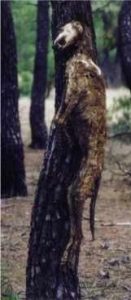 The violent death of galgos, mostly by hanging, is one of Spain’s mostly grisly secrets. It rivals, if not surpasses, in cruelty the treatment of bulls, which is open to all to see as a spectacle. A good dog may be hanged high for a more rapid death, but a loser or “sucio” dog may be hanged low so that its hind legs just touch the ground in order to maximize the suffering and prolong the agony as much as possible. I have seen dogs tied to a tree to die slowly of hunger and thirst. Dogs have been found impaled, beaten, burned, or injected with gasoline or disinfectant-the list is too disgusting to enumerate. In March 1998, I saw forty bodies in one afternoon within a ten-mile radius of Medina del Campo. They suffer this silent death in the olive and pine groves far away from human view. Galgueros have been heard to say, “I cannot shoot the dog because it is the end of the hunting season;” A dog doesn’t suffer when it is hanged”. One well-photographed galgo was hanged in Medina del Campo at the Championship meeting (Copa del Rey) in January 1997, in full view of the Mayor, the Guardia Civil, and hundreds of spectators. Last week I attended the 2000 Championship with some literature compassion for these dogs, which some galgueros laughed at with no shame or conscience.
The violent death of galgos, mostly by hanging, is one of Spain’s mostly grisly secrets. It rivals, if not surpasses, in cruelty the treatment of bulls, which is open to all to see as a spectacle. A good dog may be hanged high for a more rapid death, but a loser or “sucio” dog may be hanged low so that its hind legs just touch the ground in order to maximize the suffering and prolong the agony as much as possible. I have seen dogs tied to a tree to die slowly of hunger and thirst. Dogs have been found impaled, beaten, burned, or injected with gasoline or disinfectant-the list is too disgusting to enumerate. In March 1998, I saw forty bodies in one afternoon within a ten-mile radius of Medina del Campo. They suffer this silent death in the olive and pine groves far away from human view. Galgueros have been heard to say, “I cannot shoot the dog because it is the end of the hunting season;” A dog doesn’t suffer when it is hanged”. One well-photographed galgo was hanged in Medina del Campo at the Championship meeting (Copa del Rey) in January 1997, in full view of the Mayor, the Guardia Civil, and hundreds of spectators. Last week I attended the 2000 Championship with some literature compassion for these dogs, which some galgueros laughed at with no shame or conscience.
In February 1997, Senor Fermin Perez, a science teacher in Medina del Campo and President of Scooby Association for the Protection of Animals, photographed scores of their bodies in and around his small town of 20,000 people in Castilla y Leon. In April 1997, he appeared on Telecinco TV news with filmed evidence, and the next day a law was passed in Castilla y Leon condemning this way of killing a dog. At this writing, nearly three years later, not one prosecution has taken place or even one hanging been investigated, despite scores of other incidences? Consequently foreign anger rained down on the Regional Authorities and Medina del Campo became well known amount greyhound lovers in many parts of the world. The result was that in the year 1999, there was only one hanged body found in Medina’s nearby area. Instead, three hundred greyhounds were brought into Medina’s refuge in two months. One day in Medina I observed Scooby’s helpers pick up twenty-six galgos in one morning, all from different sources-from galgueros, from the street, from the fields, and from other rescue centres.
- Dog #129, at the Scooby shelter, cowered and urinated in terror at any human’s approach. He went eventually to America.
- Is there a home for me?
- Crowded conditions prevail at the shelter. One galgo looks on anxiously when a fight breaks out. These three photos by John Mottern
It is hard to explain such a barbaric attitude toward animals in a country so highly civilized in other respects. My personal thoughts are that Spain is a peninsular country and has been outside the mainstream of development of modern culture and thought until recently. Furthermore, the delay in establishing a democracy has not allowed the nation to mature and develop freely. Advocates of freethinking were at risk under Franco’s rule. In addition, the tight hold of the Catholic Church on the minds of the people was felt as a suppression of natural feelings and instincts, with oppression can result in venting cruelty to animals as an outlet for anger, passion, and revenge. In the years since 1975, both the law and the church have lost their dictatorial power, and Spain has changed remarkably in a short period of time. Now a new threat to the welfare of animals presents itself. Neither the people nor the authorities want to see again a condemnatory police force or a fierce judicial system. A kind of gentle anarchy reigns. Hence, laws concerning the protection of animals that are “worth nothing” are not enforced in favour of a softer general attitude by the police toward the people. Until the majority of the Spanish nation herself demands justice for animals, progress will be slow in this respect. Pressure from abroad makes little indentation on the minds of this proud nation.
One important fact, however, must be stated. I have never before met such kindness and dedication as shown by the small band of Spanish volunteers helping animals with whom I have worked in Medina del Campo. Their meetings with other groups reveal more and more hard workers and they are often in dissent from their families and friends, who cannot understand and are even indignant toward their concern for animals. These are the people who need our wholehearted support, generosity, and understanding if we want to see a better life for animals in Spain.
Galgos and Greyhounds
Despite their physical similarities, there are some essential differences between greyhounds and galgos that result from natural influences and their adaptation by breeders to the different tasks they perform.
Following our previous account of the “galgo en campo,” it is interesting to note that there are differences in the type of galgo preferred in the tougher northern Castillian areas and the softer southern Andalucian area. The hare is less hard in Andalucia, having much to eat; hence, it lacks the endurance of the northern hare more used to starker conditions. Likewise, the galgos of Adalucia are usually those crossed with the “galgo Ingles” with a short coat, good sprinting ability, and less endurance. The longer coated dog with “pelo duro” (hard coat) is thought to be closer to the original, purer galgo and is hardier and more resilient. The purer galgos, who can run for two minutes or more, are good for coursing and hunting and are not so useful for competition work, nor even for Andalucia where the runs are shorter and more suited to the sprinting qualities of the “galgo Ingles”
The “galgo Ingles” is reputed to have “codicia,” i.e. keenness. as it will chase anything that moves, as we know, including bicycles and your windshield wipers! The Spanish galgo is a more discriminating chaser and on retirement will invariably live happily with a cat without the need for training.
The type of movement required of a Spanish galgo is different from that of a track dog. The latter runs at one constant speed with one centre of gravity, but the coursing dog must pull back and accelerate or diverge left and right, adapting itself to the movements of the hare and using the neck and the tail to balance itself. There is a story about a galgo watching a lynx chase a hare on T.V. The dog, in the living room, leaned this way and that, as the hare turned and the galgo followed it!
Some aficionados feel that crossbreeding may cause the dog to lose both the endurance of the galgo and the speed of the greyhound, rather than benefiting from both. During the time in the chase when the Spanish galgo begins to warm up, the English dog begins to deflate and lose energy.
So what are the physical differences between a galgo and a greyhound (galgo Ingles)? I think we can start from the premise that the galgo is more like the original greyhound before the 1920s and the days of track dogs when the dogs were modified by breeding to adapt to shorter distances with sprinting ability. The galgo is slightly smaller than the average greyhound. Males are between 25kg and 30kg, and females between 20kg and 25kg; on average the galgo is 8cm shorter then the greyhound. The overall profile of a galgo can be said to be rectangular, whereas the greyhound is more square. The muscles of a galgo are long and flat, whereas those of the greyhound are rounded and well toned. You will notice that a galgo can sit, whereas the greyhound is often unable to fold his hind muscles comfortably into a sitting position due to their bulk and strong tone necessary for taking off from stationary into full speed as they spring from traps. The body of a galgo is longer, and proportionally the head is narrower with a less marked “stop” the nose is longer and more pointed sometimes slightly Roman, and even the tail is longer, extending down to the ground with a kink, correctly, at the end! The neck of a galgo is longer than the greyhound’s and more agile and flexible to accommodate to the twists and turns of the hare. A dog with an undershot jaw is commonly rejected by hunters because it is supposed that the dog cannot grab and kill the hare.
The feet of the galgo should be hare-like, that is flat to the ground, while the greyhound has round feet like a cat’s. The eyes of the galgo are almond shaped and slanting, while those of a greyhound are oval and more prominent. The ears of the galgo are more fleshy than the greyhound’s, but both are rose shaped.
The pin bones of the greyhound are higher and represent the corners of its square profile, whilst the galgo’s slope downwards and are out of sight. The coat of a galgo can be short and fine like a greyhound’s but it also may be medium long and hard. This makes the galgo able to cope with brambles and tough undergrowth, and they may even be used to hunt more aggressive animals such as wild boar, having a more protective coat.
The colours of the galgo can be stunning; some are tricolour, and rich brown has even been seen. Dramatic contrasts in colour and the distribution differentiate the galgo from the greyhound; facial whiskers and moustaches add distinction.
The gallop of the galgo and the greyhound are also different; the greyhound’s gallop is called the double suspension gallop with all four feet together underneath the greyhound lifted in the air, followed by all four feet stretched out off the ground. The galgo’s gallop is a more common diagonal gallop.
The character, however, of the galgo and greyhound is similar; a little shy and low in self-confidence, craving affection, willing to please, and ever grateful for your understanding and constancy. On retirement, the ex-track racer can be more of a handful than the galgo as a chaser of cats and small furry animals, but this is due to conditioning and the type of racing to which it has been subjected. We do find also that the galgo can be relied upon more than the greyhound to be well behaved and more placid in groups or in the company of other dogs.
There is an association called the Club Nacional de Galgo, whose President is Bartolome Ramirez Castro, a great breeder and lover of Spanish galgos. The members promote the use of galgos in the countryside for hunting. Bartolome has provided sanctuary for numerous unwanted galgos over the years, and we liase with him over the adoption of his galgos as pets. He “shows” galgos, and preserves and promotes the pure galgo breed.
Track Racing in Spain
The general rules of track racing are well known to readers from the USA, Britain, and Australia, so I will not reiterate them. I have already mentioned the eighteen tracks viable in Franco’s day in Spain using Irish dogs. Race tracks remained in three locations when I became involved in 1991: Barcelona (two tracks, 1000 dogs), Valencia (450 dogs), and Mallorca (300 dogs). The large number of dogs serving each track reflects the huge number of races and meetings weekly. There were two meetings per day, seven days a week, with fourteen races (some of them eight dog races) at each meeting. Hence, despite the large number of dogs involved, they still run three or four times a week in Spain, whereas dogs in Britain race not more than once a week because of the immense stress involved in a race.
- The track kennels in Mallorca as Anne saw them in 1991. She reported their condition to the World Greyhound Racing Federation who later closed them.
- 40 Irish bitches were kept here in 1999 in the gypsy ghetto in Mallorca after the closure of the track. We removed them all to homes abroad.
- Firoy seen here at the new Mallorca track kennels in 1999. 300 Irish bitches like Firoy were removed to homes abroad by Greyhounds In Need into the hands of adoption groups in Europe and UK.
- Firoy seen here in Switzerland, thanks to New Graceland.
In Spain, racing dogs are kept in cages after the American style of kennelling, but there are differences. The cage in Spain is solid, not of mesh, only one-meter square, and there can be two dogs in each cage, so only one can lie down at a time. Furthermore, the new cages in Barcelona designed by the previous manager of the track are solid on all four sides, and the dog, in solitary confinement, can only be peered at from above by an Anthropoid. Such a psychological abomination can only emanate from a human with no awakening whatsoever to a sense of compassion.
The dogs are exercised in American style-all bitches together and all males together. Fights occur but are rare due to the extraordinarily low energy levels of these dogs, which, as I observed in Valencia, were over-raced and fed mainly on stock-soaked bread. Veterinary care is non-existent. There are vets attached to the track in Barcelona who are kept at arm’s length by the more caring trainers. They do not check dogs before or after racing, nor do they watch the racing. I have seen them reading newspapers in a backroom in the Meridiana track, and they weren’t even thought significant enough to be introduced to me on my several tours organized proudly by the manager.

A rescued greyhound from the closed Pabellon Track howls in distress. We think she was probably suffering from drug withdrawal.
Photo by John Mottern
Stimulants and suppressants are used without shame. In Mallorca, I stood beside a trainer while he injected cortisone into the left shoulder of each of the day’s racers as they entered the transporter to go to the track. My protestations were regarded with amazement. Two of our dogs who came through quarantine were suffering from Cushing’s syndrome, signifying the abuse of cortico-steroids.
Amphetamines, cocaine, alcohol, caffeine, and aspirin are used to suppress pain, alter performance, or get the dog around the track. At one Championship meeting, two out of the three placed winners had positive drug tests, but the test results were dismissed on a technicality, and the race results stood. I have seen a dog with distemper at the Barcelona kennels. Vaccination is never taken seriously by the Irish or Spanish.
Anectine is used intramuscularly by trainers to kill a greyhound. Trainers believe that this is humane. Even some vets use anectine in Spain to kill animals. Anectine is a paralysing agent, which, because the animal cannot even blink, makes the trainer think the dog is dead. The dog is in fact fully conscious but unable to move and dies of suffocation because of the paralysis of the lung muscles. It is barbaric. In 1992, I provided the managers and all the trainers with information in Catalan regarding the cruelty of using anectine, but is has not been heeded. It can be bought cheaply and is easy to give, so it continues to be used instead of the correct euthanasia, barbiturate, which induces unconsciousness and death.
The lack of veterinary care is a disgrace. In Valencia, I witnessed greyhounds in great distress, for example: haemorrhaging from the anus: fractured limbs: septic arthritis: and, rhabdomyolisis. I offered to pay for a vet to visit or to take the dogs to a vet myself, but my offer was flatly refused.
All this has caused me immense grief, and I have tried to walk the tight rope of liasing with track managers in order to keep alongside the dogs, while at the same time exerting pressure on them to change their ways. I will say that I do not feel that this is deliberate cruelty. This is cruelty by negligence, ignorance, and stubbornness that rejects the introduction of education and modern ideas of animal welfare. Spain is a country of pride and tradition and not renowned for its flexibility.
Spain is a member of the World Greyhound Racing Federation with America, Australia, Britain, and Ireland. It constantly amazes me that the other members of WGRF have not intervened more aggressively into their associate’s racing methods and flouting of the rules. The integrity of the WGRF will always be diminished until something is done about it.
“Inspections” of the kennels take place at noon, when twelve out of thirteen of the trainers, (as there used to be: there are now only seven) have gone to the track, and only one particular trainer is available for inspection. He is the best. On this basis, the reports are written.
I make no apology for my frankness on this matter. The suffering of these dogs is so immense it bypasses other more sensitive considerations.
We take retired dogs for adoption from the seven hundred still serving Meridiana track in Barcelona, but we are barely scratching the surface. Barcelona is a thousand-mile round trip to Medina.
Dogs are still being exported from Ireland to Spain. Despite what the Bord claims in writing, agents of the Bord Nag Con are selling these dogs to the Spanish in the Limerick, Shelborne, and Cork Sales. These are considerable publicity in 1991-92 from Spanish and English sources describing the poor treatment of the Irish dogs in Spain, but it has been dismissed by the three agents and by the Bord.
I ask myself why we who have other jobs and family commitments have to devote ourselves instead to these problems, for example rescuing three hundred unwanted Irish bitches from Mallorca, many of them in shocking condition. The operation cost us thousands of pounds, but I do not regret a penny, and I would do it all over again. But imagine my anger when I heard of eight new tracks opening in Vietnam and two more in Italy while rescuers were still in the process of removing the entire ex-racing stock from Naples.
The vice of gambling brings about disaster, both human and animal, whenever it establishes itself. We have to live with it. It is not going to go away.
We will fight on, hoping for more doors to open in Europe to help these unwanted greyhounds of Spain. Quarantine in Britain may be disappearing, but the requirement of a blood test six months ahead means kennelling them for that period in Spain. We will comply and overcome somehow.
The Greyhound in Straight Racing (“Liebre Mecania”)
The phenomenon of racing six dogs along a straight “shaved” or sand track for betting arose because of the embargo on hunting outside the season.
It is believed to have started in the Canary Islands along the beaches. The first oval dog track in Spain was on the Island of las Palmas. Galgueros, some on horseback, raced their galgos every weekend along a track of 500m or 700m, chasing a mechanical lure operated by a wheel with a crank or wire like a drag hare. The lure would be the dried fur of a rabbit or hare, stuffed with straw. These dogs can be galgos, greyhounds, or crosses, although the distance is long in hot weather for a purebred Irish dog. This is how racing dogs are trained and has become a “competition” in itself.
In 1987, the Federacion Espanol, recognizing the large amount of interest in this type of racing, organized in Cuellar the first Campeonata de Espana of Liebre Mecanica, drawing up a number of rules. Prizes of money were awarded, with about seventy greyhounds, participating in one event. Good control of food, weight, health, wound care, recuperation, and training were acknowledged as necessary for the integrity of the sport.
In Medina del Campo, we have lost about twenty greyhounds and galgos in eighteen months on four different occasions. No amount of security can prevent this. Metal doors are broken down, locks are smashed, and even high windows are broken. Even a human presence may be seriously threatened. The GuardMost dogs are a mixture of Irish and English blood, some favouring hard terrain and others, with less resistance, favouring sand.
OTHER PROBLEMS IN SPAIN
Working For Animals
Caring for animals in Spain does not invite support or applause-rather the opposite. Human charities do well, and the nation is generous toward these, but workers for animals have to be seen working for human charities as well, or they may be treated with hostility. This leads naturally to questions of finance. Animal welfare societies cannot expect donations from the government nor the Spanish population; hence they are seriously dependent on us in northern Europe and North America.
The Robbery of Greyhounds
The thieving of greyhounds is an ever-present problem in Spain. One trainer/breeder in Tembleque expects to lose sixty of his two hundred dogs every year. Valencia track once had seventy Irish bitches stolen from the kennels at gunpoint one night. Gypsies will steal these dogs to sell for good money.
It is a mystery where these dogs go. They are rarely ever found again. It is thought that they travel and that they are taken long distances across Spain, e.g. from Andalucia to Castilla y Leon, Castilla y Leon to Toledo. Fermin Perez even hand Luna, his own pet greyhound, stolen. She was elderly, sterilized, and micro chipped. Miraculously, she mysteriously reappeared nearly a year later in January 2000. Recently there was a rumour that a warehouse had been discovered in Toledo with five hundred stolen greyhounds. Another horrible rumour is that greyhounds are used as bait in dog fighting to teach the pit bulls agility. Conclusions can also be drawn when greyhounds and other dogs disappear when circuses with lions hit the town. Only three or so months ago, a zoo near Medina “entertained” an audience of children by showing a snake consuming a live hamster.ia Civil are very wary of getting involved, and I am told they will not go into gypsy settlements. I am sorry for being so frank and politically incorrect, but I speak facts and common knowledge in Spain.
Last summer, we bought thirty-nine greyhounds from gypsies in Mallorca for £1,100. The next day, after their arrival in Medina, a 24-hour drive away, three vans turned up at the refuge demanding the dogs. All the dogs were rapidly moved to boarding kennels to protect them. Sometime later, one bitch from this group was stolen, who sadly had just recovered from grave abdominal surgery and had been nursed by Fermin on intravenous fluids around the clock for almost a week. She had miraculously recovered, only to face a worse fate.
How Do We Survive?
Such tragedies make working in Spain for animals very tough-going emotionally. One has to be very strong, even seemingly cold, to survive. The alternative is to become crazed or suffer a mental breakdown. The most necessary ingredient for survival is for us to cling in a supportive way to each other. When personal relations collapse and one becomes isolated and unsupported, this dangerously heralds the end of the work for these blighted animals. At the sharp end of this war, it is impossible to survive without the love and understanding of our fellow workers. No one can continue to give up so much in terms of time, self fulfilment, money, and possessions and also suffer attacks from critics. It is a perilous path we tread, and we would not feel love for these animals if we ourselves were not sensitive, open, and fragile.
To defend the abused and cruelly treated day after day, year after year, requires dedication and passion and even the fire of anger to inspire, to ignite, and to give energy, power, and strength.
We also need knowledge, intelligence, and science to care properly for these dogs. Veterinary advice and treatment, good hygiene and nutrition, prophylactic vaccination and worming programs, sterilization and sensible identification are all essential if we are to call ourselves carers. Without these, we are meddling in sentiment and ignoring the realities.
So strength, knowledge, and love are the three essential ingredients, for handling the problem facing the greyhounds of Spain. It will be some decades before there is a satisfactory and permanent solution. We try to help as many as we possibly can with publicity, perseverance, promotion, persuasion, and political pressure. The positive results of these are the vast numbers of dogs who come into our hands. At the time I am writing, Scooby is receiving an average of ten greyhounds a day into their refuge.
We need your help. The task is mammoth.
Help us to help them.
Anne Finch 1999
________________________________________________________________
Acto de Desagravio al Galgo Espanol
En Peraleda de la Mata, a las 17 horas del dia 21 de Junio de 1997
Bartolome Ramirez Castro
Club Nacional del Galgo Espanol
Los aqui presentes y muy especialmente los miembros del Club Nacional del Galgo Espanol venidos de los cuatro puntos cardinals, queremos hacer un “Acto de desagravio al Galgo” que corretea por nuestros campos:
A ti:
Fiel amigo, milenario en la compania del hombre.
Animador regio en la caza por ducados y reinos y, a la vez, enraizado en el pueblo llano, seguidor y companero de hombres y mujeres , curtidos al frio y al sol, en caravanas errantes. Aliado indiscutible a la hora de coger una liebre para alegrar el “caldero de cada dia”.
Base de sustento de estas familias errantes a traves de los tiempos.
Noble companero que desprecias el peligro de fracturas, heridas e incluso la muerte, para sequir con ahinco a la liebre corredora que, a la velocidad de vertigo atraviesa la llanura, pasando entre maleza, arboles o alambreras y llegar al perdedero.
Carinoso con los ninos, defensor a ultanza de ellos, en caso necesario.
Atleta por nacimiento. Protagonista en ferias y fiestas, donde tus duenos disfrutan viendote correr y atravesar el primero la meta deseada.
Animador de tantos y tantos lances de caza, donde hombres y mujeres se juntan en torno a ti, para salir al campo y, olvidando problemas, pasar un dia feliz.
Corredor de fondo, que en pleno esfuerzo tras la liebre, no reparas si el que te sigue va a pie, caballo, o te mira desde una loma para no perderse el natural y bello lance, esculpiendo vuestras siluetas en el horizonte.
Inspirador de pintores, escultores, poetas y cantaores, recreo de los sentidos en lienzos, esculturas, versos y cantes.
Quien ha visto correr un galgo en el campo tras una liebre, recordara uno de los espectaculos mas bellos de la Naturaleza.
Y TODO GRACIAS A TI.
Y SIN TENER EN CUENTA TODO ESTO, NUNCA EXIGES NADA A CAMBIO.
Lo mismo duermes en un pajar que al raso, atado a un arbol que a la rueda de un carro, abrigado en una cuadra o en el suelo de “salvao”
!Eso si! Orgulloso al coger la liebre y majestuoso al traerla a la mano.
Por el contrario….! Que mal pago te damos!
Tras unos anos de servicio, te vemos abandonado huidizo por los malos tratos
Sin comprender el mal que los hombres te causamos llegando a morir en los pinos
Por la mano ingrata de algun desalmado.
Apenados por estos terrorificos hechos, todos los que aqui nos encontramos con un nudo en la garganta, de ver al amigo fiel maltratado, prostestamos energicamente en este acto de desagravio.
Desde aqui hacemos una llamada a la gente de bien, para que nunca abandonen al AMIGO MAS FIEL.
Bartolome Ramirez Castro, Presidente del Club Nacional del Galgo Espanol.
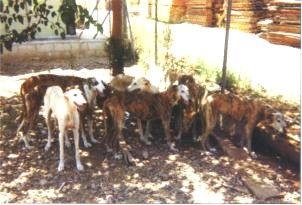
Bartolome is a galgo enthusiast in Cordoba who has been rescuing and taking in unwanted galgos for over 40 years since he was a teenager. Only in recent years since the plight of the galgos came to our knowledge, have we been able to take dogs off him for export and adoption.
Act of Contrition to the Spanish Greyhound.
In Peraleda de la Mata, at 5.p.m. on the 21st of June 1997.
Bartolome Ramirez Castro
Club Nacional del Galgo Espanol
Those present, and especially those members of the National Club of Spanish Greyhounds, from all the four quarters of Spain, wish to make an Act of Contrition to the Greyhound who runs over our land:
To you:
Faithful friend, man’s companion through the ages.
Royal heart of the chase of dukedoms and kingdoms while still rooted in the common people; follower and companion of men and women, hardened by the cold and the sun beside roaming caravans; indisputable ally in the catching of the hare to provide interest to the day’s pot.
Provider of sustenance to those nomadic families who wander throughout time. Noble companion who, despite risk to limb and to life, chases with eagerness the hare who crosses the plain at frantic speed among bushes, trees, and fences until it escapes.
Lover of children, defending them, when called upon, to the utmost.
An athlete by birth. Entertainer of feast days and holidays when your owner enjoys watching you race and cross the finish line.
Author of many, many thrilling brave pursuits, where men and women gather around you, to go to the fields and forgetting all their daily problems, enjoy a happy day.
Runner of endurance, who in giving all to the chase, cares not whether he who follows you is on foot or horseback or whether he watches you from a hill so as not to miss your natural and beautiful turns with the silhouette of your form sculpted against the horizon.
Inspiration of painters, sculptors, poets, and flamenco singers, a joy to the senses in paintings, sculptures, verses, and songs.
Those who have seen a coursing greyhound running over the fields will ever remember one of the most beautiful sights of Nature.
AND THANKS TO YOU.
And with no heed to this, you demand nothing in return.
You sleep either in a barn or in the open air, tied to a tree or to the wheel of a cart, sheltered in a stable or on a floor full of bran.
It’s true! How proud it is to catch the hare and how majestic to bring it into our hands.
But how badly we repay you!
After years of service, we see you abandoned
Fearful of mistreatment
Without understanding the evil we men do to you
Facing death in the pine woods by the ungrateful hand of the heartless.
Saddened by these horrible acts, all of us gathered here, with a lump in our throats to see our faithful friend mistreated, do strongly protest in this act of contrition.
We call upon all good men never to abandon OUR MOST FAITHFUL FRIEND.

